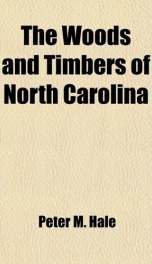the woods and timbers of north carolina

Purchase of this book includes free trial access to www.million-books.com where you can read more than a million books for free. This is an OCR edition with typos. Excerpt from book: THE Trees of North Carolina. TREES BEARING CONES. PINES.These have their fruit in large scaly cones, popularly called burs, and have evergreen needle-shaped leaves, two to five enclosed in a sheath at their base. 1. Yellow Pine. (Pinus mitis, Michx.)This, with us, is called Short-leaved Pine and Spruce Pine. The first is objectionable, because we have at least two species with shorter leaves ; and the second, because another is more appropriately called by that name. I have, therefore, adopted the name by which it is known in the Middle States, and recommend its use here, as it is much to be desired that there be a greater uniformity in the popular designations of our forest trees. In the great confusion now prevalent, it is often quite impossible to ascertain what is meant by the names of our most common trees and other plants. This is, perhaps, the most widely diffused of all our Pines, it being common from New England to Florida, mostly in light clay soils. With us it is found from the coast to the mountains, but more rarely in the Lower District, and it enters into the composition of most of our upland forests. It isfrom 40 to 60 feet high, with a circumference of 4 or 5 and even 6 feet. The limbs on the upper part of the tree are more inclined towards the trunk than those of our other species, so as to give somewhat of a pyramidal form to the top. The leaves are 2 to 5 inches long, generally two, but sometimes three, in a sheath. The cone or bur is the smallest of all our species, rarely attaining a length of 2 inches, the tips of the scales armed with slender short prickles. The heart-wood is fine grained and but moderately resinous ; but the sap-wood soon decays. The timber is extensively used in house and ship building, though not deemed so valuable as that o...
Info about the book
Author:
Series:
Unknown
ISBN:
1234885220
Rating:
3.5/5 (3)Your rating:
0/5
Languge:
English
Users who have this book
Users who want this book
What readers are saying
What do you think? Write your own comment on this book!
write a commentif you like the woods and timbers of north carolina try:
Other books by this author
Do you want to exchange books? It’s EASY!
Get registered and find other users who want to give their favourite books to good hands!

